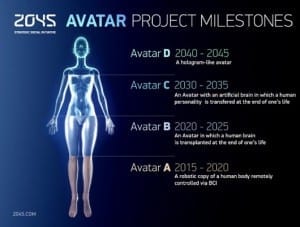The initiative has also received the support and blessing of the Dalai Lama.
Russian media magnate Dmitry Itskov is heading “Avatar,” a tremendously ambitious and far-reaching multidisciplinary research project that aims to achieve immortality in humans within the next three decades. He plans to do it by housing human brains in progressively more disembodied vehicles, first transplanting them into robots and then, by the year 2045, by reverse-engineering the human brain and effectively “downloading” human consciousness onto a computer chip.
Fact or fiction?
When speculating on seemingly unobtainable goals such as this, one must be careful not to believe that improbable technological advances automatically become more likely simply by looking further away in the future. This is the cognitive trap that, for instance, has seen many leading IT experts predict the development of a human-level artificial intelligence at roughly twenty years in the future for at least the past five decades.
Looking at Avatar’s proposed timeline, Itskov’s project seems to suffer from the same fallacy. Certainly, if we borrow Carl Sagan‘s rule that “extraordinary claims demand extraordinary proof,” the project comes up short for the time being; it does, however, have the merit of basing most of its steps on technology that is either in the works or of general interest. And with the rate of technological change continuing to accelerate, the project’s goals may be within reach, although not necessarily within the project’s aggressive timeline.
The roadmap to immortality
The first of the proposed steps, to be completed before the end of the decade, would be to create an android “avatar” controlled entirely by a brain-computer interface. The system would at first be of interest to physically challenged people, but might also enable people to work in hazardous environments or perform dangerous rescue operations.
As futuristic as this vision may seem, Itskov is not the only person to share it. DARPA allotted US$7 million of next year’s budget to the development of interfaces enabling a soldier to guide a semi-autonomous bipedal machine and allow it to act as the soldier’s surrogate. Other researchers have reported being able to exert basic control over the movement of a humanoid robot using brainwaves alone, and many are working on refining this technology.
The second step would be the creation of an autonomous life support system for the human brain, which could then be integrated into the previously developed “avatar” by 2025. If the efforts are successful, immobile patients with an intact brain would be able to regain the ability to move via their new synthetic bodies, and a varied range of bio-electronic devices might become possible, creating superimpositions of electronic and biological systems.
Not a great deal of research is going into this at the moment – in fact, the closest match would have to be the research of Dr. Robert J. White who, back in the 70s, managed to perform several head transplants in monkeys. Building an artificial environment in which a brain could not only survive, but also continue working to full effect, is sure to prove a much harder task.
By 2035, Itskov hopes to be able to reverse-engineer the human brain and find a means of “downloading” its consciousness to a synthetic version. Coupled with the previous advancements, this would allow humans to achieve cybernetic immortality. It would also lead to the creation of a human-like artificial intelligence, and even provide opportunities for ordinary people to restore or enhance their own brains, for instance by manipulating memories.
While there is no current research going into transferring your consciousness into a silicon chip, there is plenty of interest among neuroscientists in better understanding the inner workings of the brain. Although we are just scratching the surface, recent advancements – such as a robotic arm that can analyze the electricity patterns of single neurons – are certainly steps in the right direction.
via Gizmag – Dario Borghino








